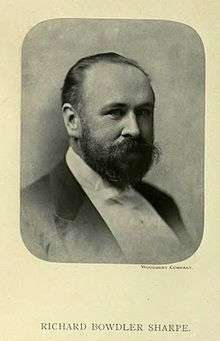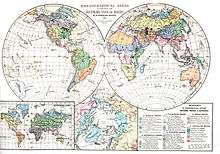Richard Bowdler Sharpe

Richard Bowdler Sharpe (22 November 1847 – 25 December 1909) was an English zoologist and ornithologist who worked as curator of the bird collection at the British Museum of natural history. In the course of his career he published several monographs on bird groups and produced a multi-volume catalogue of the specimens in the collection of the museum. He described several new species of bird and a several species of bird including Sharpe's longclaw (Hemimacronyx sharpei) and Sharpe's pied-babbler (Turdoides sharpei) are named in his honour.
Biography

Richard was born in London, the first son of Thomas Bowdler Sharpe. His grandfather, Reverend Lancelot Sharpe was Rector of All Hallows Staining. His father was a publisher on Skinner Street and was best known for being the publisher of Sharpe's London Magazine, an illustrated periodical (weekly but monthly from 1847). His care from the age of six was under an aunt, Magdalen Wallace, widow of the headmaster at Grammar School in Sevenoaks and went to school in Brighton. At nine he studied at The King's School, Peterborough receiving a King's Scholarship. He then moved to Loughborough Grammar School. He returned to London at the age of sixteen and worked as a clerk with W. H. Smith & Sons. He already took an interest in ornithology and was interested in writing a monograph on the kingfishers. After two years, in 1865, he joined the company of the bookseller Bernard Quaritch and had an opportunity to examine ornithological books and began to work in earnest on his monograph, purchasing specimens of kingfishers from a meagre income. At nineteen, in 1867, he became a librarian at the Zoological Society of London on the recommendation of Osbert Salvin and Philip Sclater and he completed his Monograph of the Kingfishers (1868–71) during this period. The book was produced in parts with 121 illustrations.[1]
He then began to collaborate with Henry Dresser on A History of the Birds of Europe but this had to be abandoned because of his new appointment. On the death of George Robert Gray in 1872 he joined the British Museum as a Senior Assistant in the Department of Zoology, taking charge of the bird collection. On December 3, 1867 he married Emily Eliza,[2] daughter of J. W. Burrows of Cookham dedicating Tanysiptera galatea emiliae to her in 1871. They had ten daughters and many of them contributed to his books (and of other authors too) by hand colouring the lithograph plates. One daughter, Emily Mary, worked in the entomology department of the Natural History Museum between 1905 and 1925.[3] He became Assistant Keeper in 1895, a position he held until his death from pneumonia in 1909. He died at his home in Chiswick.[1] In 1911 a ₤100 civil pension was granted to his wife and daughters Emily Mary, Ada Lavinia and Eva Augusta.[4]
Contributions to ornithology

As curator of the bird collections, Sharpe's main work was in classifying and cataloguing the collections. He also played a major role in acquiring private collections by persuading wealthy collectors and travellers to contribute to the museum. In 1872 the museum had 35,000 bird specimens; the collection had grown to half a million specimens by the time of his death. These included the bequests of Allan Octavian Hume, Osbert Salvin and Frederick DuCane Godman, the industrialist and amateur ornithologist Henry Seebohm, Colonel John Biddulph, C. B. Rickett, F. W. Styan, Alfred Russel Wallace, George Ernest Shelley, Philip Sclater and the bird illustrator John Gould.[1]
Sharpe founded the British Ornithologists' Club in 1892 and edited its bulletin. He wrote thirteen and a half of the 27 volumes of the Catalogue of the Birds in the British Museum (1874–1898). His handsome Birds of Paradise, published in two large volumes (over 21 inches x 14 inches) in 1891 and 1898, presented these colourful birds to the world: as Sharpe wrote in his preface, "a great number of the species are here figured for the first time".[1]
Sharpe was nominated at the International Ornithological Congress at Paris in 1900 to preside over the London Congress in 1905.[1]
Personality
Sharpe was noted as a genial and humorous person. Richard Meinertzhagen and his brother were introduced to the bird collections by him. He was fond of children, having ten daughters himself. He was also known for his practical jokes and pranks. When Eugene Oates was working on the Fauna of British India, he found the notes lying on a table and filled up a stray statement on the call of a white wagtail which went into print (The note of this species is a prolonged "Pooh."). On one occasion, Sharpe ascended the Eiffel tower with friends but became hysterical on reaching the top, with Ernst Hartert and several others having to restrain him and prevent him from jumping off.[1][6][7] A regular at the Savage and Whitefriars Club, he and his wife threw a party in February 1888 with 120 guests and entertainment that included humorous sketches, songs, recitals and music.[3]
Honours
Sharpe was awarded an honorary LL.D. by the University of Aberdeen. He was fellow of the Linnean Society and the Zoological Society of London. A gold medal was awarded to him in 1891 by the Emperor of Austria.[8] Many species and subspecies have been named after him including Sharpe's starling (Cinnyricinclus sharpii), Bycanistes fistulator sharpii, Sharpe's Apalis (Apalis sharpii) Sharpe's akalat (Sheppardia sharpei), Sharpe's pied-babbler (Turdoides sharpei) and the Burmese subspecies of the sarus crane (Grus antigone sharpii). A genus Sharpia was erected but is now considered to be synonymous with Ploceus.[9]
Publications
- Monograph of the Paradiseidae, or Birds of Paradise, and Ptilonorhynchidae, or Bower-birds. Taylor & Francis for Henry Sotheran & Co, 1891-98.
- Hand-book to the birds of Great Britain (1894)
- Wonders of the bird world (1898) illustrated by A.T. Elwes
British Museum catalogues

- Catalogue of the Accipitres, or diurnal birds of prey, in the collection of the British Museum. (1874).
- Catalogue of the Striges, or nocturnal birds of prey, in the collection of the British museum. (1875).
- Catalogue of the Passeriformes, or perching birds, in the collection of the British museum. Coliomorphae... (1877).
- Catalogue of the Passeriformes, or perching birds, in the collection of the British museum. Cichlomorphae, pt.I... (1879).
- Catalogue of the Passeriformes, or perching birds, in the collection of the British museum. Cichlomorphae, pt.III-[IV]... (1881–83).
- Catalogue of the Passeriformes, or perching birds, in the collection of the British museum. Fringilliformes, pt.I... (1885).
- A monograph of the Hirundinidae, (1894).
- A Monograph of The Alcedinidae, or Family of Kingfishers (1868–1871).
- Catalogue of the Passeriformes, or perching birds, in the collection of the British museum. Fringilliformes, pt.III... (1888).
- Catalogue of the Passeriformes, or perching birds, in the collection of the British museum. Sturniformes... (1890).
- Catalogue of the Picariae in the collection of the British museum. Coraciae... (1892).
- Catalogue of the Fulicariae... and Alectorides... in the collection of the British museum. (1894).
- Catalogue of the Limicolae in the collection of the British museum. (1896).
- Catalogue of the Plataleae, Herodiones, Steganopodes, Pygopodes, Alcae, and Impennes in the collection of the British museum. (1898).
References
- 1 2 3 4 5 6 Fagan, C.E. "Obituary: Richard Bowdler Sharpe" (PDF). British Birds. 3 (9): 273–288.
- ↑ "Cookham". Reading Mercury. 7 December 1867. p. 5 – via British Newspaper Archive. (subscription required (help)).
- 1 2 Jackson, Christine E. (1994). "Richard Bowdler Sharpe and his ten daughters". Archives of Natural History. 21 (3): 261–269. doi:10.3366/anh.1994.21.3.261.
- ↑ "Civil list pensions are granted". Dundee Courier. 7 July 1911. p. 5 – via British Newspaper Archive. (subscription required (help)).
- ↑ Sharpe, Bowdler (1893). "On the zoo-geographical areas of the world, illustrating the distribution of birds". Natural Science. 3: 100–108.
- ↑ Meinertzhagen, R. (1959). "Nineteenth century recollections". Ibis. 101 (1): 46–52. doi:10.1111/j.1474-919X.1959.tb02355.x.
- ↑ Allen, J. A. (1910). "Richard Bowdler Sharpe" (PDF). The Auk. 27 (2): 124–129. doi:10.2307/4071104.
- ↑ [J.E.H.] (1910). "Obituary: Dr. R. Bowdler Sharpe". Ibis. 52 (2): 352–357. doi:10.1111/j.1474-919X.1910.tb07909.x.
- ↑ Jobling, James A. (2010). Helm Dictionary of Scientific Bird Names. Bloomsbury Publishing. p. 355.
External links
| Wikimedia Commons has media related to Richard Bowdler Sharpe. |
-
 Sharpe, Richard Bowdler (DNB12). Wikisource.
Sharpe, Richard Bowdler (DNB12). Wikisource. - "Biography" at Genealogy and History of the Bowdler Family
- A hand-book to the birds of Great Britain Volumes 1 2 3 4
- A monograph of the Alcedinidae : or, family of kingfishers
- A review of recent attempts to classify birds (1891)
- A monograph of the Hirundidae (1885)
- Catalogue of African birds in the collection
- A hand-list of the genera and species of birds : nomenclator avium tum fossilium tum viventium. Volumes 1 2 3 4 5
- A chapter on birds : rare British birds (1895)
- Sketch-book of British birds (1898)